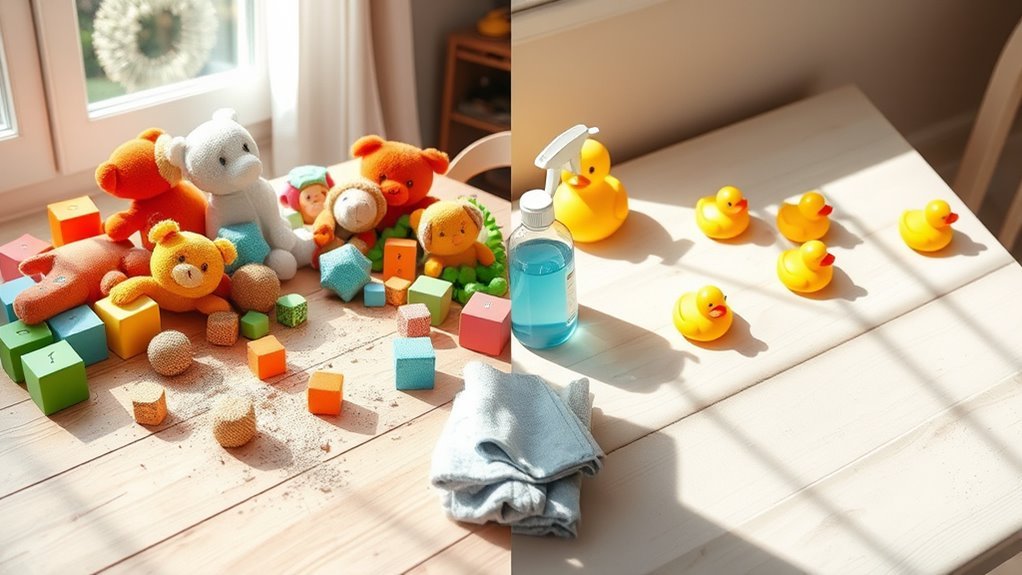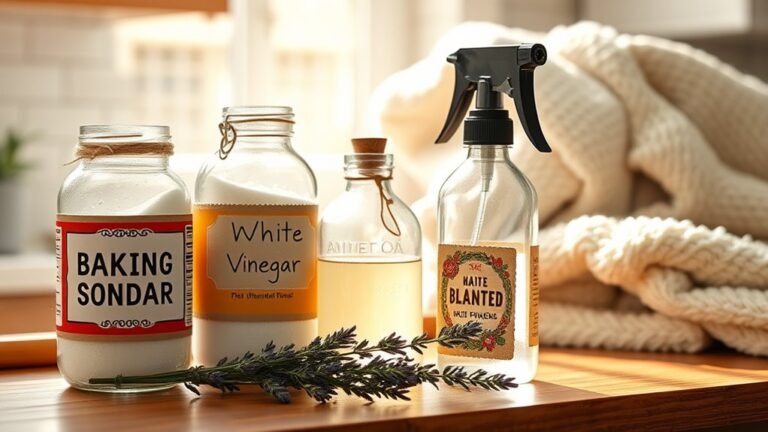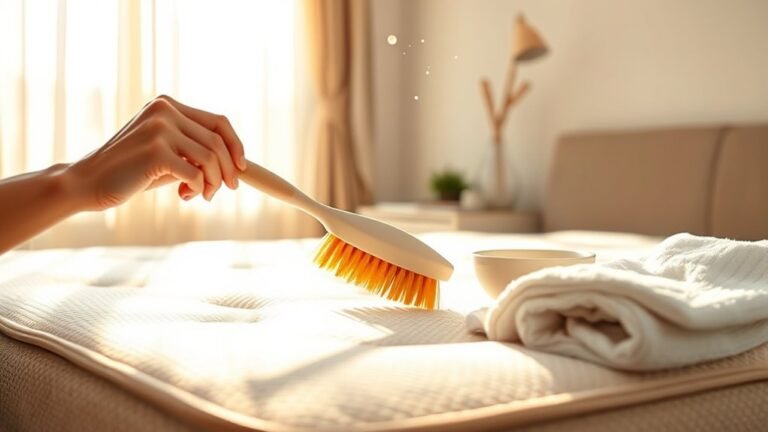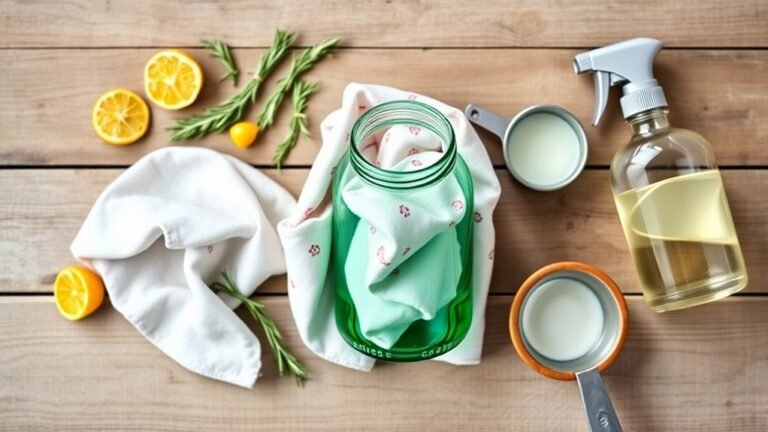Cleaning Tips Before and After Baby Items
You’ll want to thoroughly clean and sterilize new baby bottles before first use by washing them with warm soapy water and boiling or using a steam sterilizer. Regularly wash baby clothes with gentle, fragrance-free detergent and clean toys with mild soap and water, then air dry. Wipe down feeding surfaces and diaper changing areas with baby-safe disinfectants to prevent germs. Keeping these routines consistent helps guarantee your baby’s items stay safe and hygienic—exploring a few more tips will make care even easier.
Preparing New Baby Bottles for First Use

Before you use new baby bottles for the first time, it’s important to give them a thorough cleaning. Proper bottle preparation guarantees your little one stays safe and healthy, freeing you from worries about germs or residue. Start by washing each part with warm soapy water, using a bottle brush to reach every nook. Rinse well to remove soap traces. Pay special attention to the nipples and caps, where milk can hide. Although full sterilization is essential, initial cleaning sets the stage for effective sterilization later. Following these sterilization tips helps you maintain freedom from infections and keeps feeding hassle-free. By establishing a clean routine early, you’re taking control and creating a safe feeding environment your baby deserves. Your freedom to enjoy every moment starts with smart bottle prep.
Effective Sterilization Methods for Baby Feeding Equipment
There are several effective sterilization methods you can use to keep your baby’s feeding equipment safe from harmful bacteria. Choosing the right sterilization techniques guarantees feeding safety without complicating your routine. You don’t have to feel restricted—these methods give you freedom to pick what fits your lifestyle best:
Effective sterilization keeps your baby’s feeding gear safe while fitting smoothly into your daily routine.
- Boiling: Submerge bottles and nipples in boiling water for 5 minutes. Simple, chemical-free, and reliable.
- Steam Sterilizers: Electric or microwave steam sterilizers quickly kill germs without chemicals, perfect for busy parents.
- Sterilizing Solutions/Tablets: Soak equipment in approved sterilizing solutions, a convenient option if you’re on the go.
Cleaning and Disinfecting Baby Toys Safely

You want to keep your baby’s toys clean without using harsh chemicals that could harm them. Simple safe cleaning methods like washing with mild soap and water often do the trick. When disinfection is needed, choosing gentle techniques guarantees the toys stay germ-free and safe for your little one.
Safe Cleaning Methods
Although baby toys can quickly become a hotspot for germs, you can clean and disinfect them safely with the right methods. Choosing baby safe solutions guarantees your little one stays protected without harsh chemicals. Natural disinfectants, like vinegar or baking soda, work wonders and keep things gentle. To keep your cleaning routine effective and worry-free, focus on these tips:
- Use warm, soapy water for daily cleaning to remove dirt and grime.
- Rinse thoroughly to avoid residue from cleaning agents.
- Opt for air drying to prevent moisture buildup that breeds bacteria.
Disinfection Techniques
When you want to keep your baby’s toys truly germ-free, proper disinfection techniques are vital. Start by choosing safe disinfecting surfaces and products designed for baby items. Avoid harsh chemicals; instead, opt for solutions like diluted white vinegar or baby-safe disinfectant wipes. Establish cleaning schedules that fit your lifestyle—perhaps disinfect toys weekly or after sick days. Regularly washing toys with warm, soapy water before disinfecting helps remove dirt and germs effectively. Don’t forget to air-dry toys completely to prevent mold or bacteria growth. By sticking to consistent cleaning schedules and using gentle disinfecting methods, you guarantee your baby’s playthings stay safe and hygienic, giving you peace of mind and your little one the freedom to explore worry-free.
Washing Baby Clothes: Best Practices and Detergents
Since baby clothes are in constant contact with your little one’s sensitive skin, choosing the right washing methods and detergents is essential to keep them clean and irritation-free. When it comes to detergent selection, opt for fragrance-free, hypoallergenic formulas that avoid harsh chemicals. Skip fabric softeners as they can leave residues that irritate delicate skin. Wash clothes in warm water to effectively remove dirt and germs without damaging fabrics.
Choose gentle, fragrance-free detergents and warm water to keep baby clothes clean and irritation-free.
Remember these key points:
- Use gentle, baby-specific detergents free from dyes and perfumes
- Avoid fabric softeners and dryer sheets to prevent skin irritation
- Separate heavily soiled clothes and pre-treat stains before washing
Caring for Baby Bedding and Crib Linens

Because baby bedding and crib linens come into direct contact with your little one’s skin and are exposed to spills and messes, keeping them clean is essential for your baby’s comfort and health. Choosing safe bedding materials that meet crib safety standards lets you maintain a cozy, secure sleep space.
Here’s a quick care guide:
| Bedding Material | Washing Temp | Drying Method |
|---|---|---|
| Cotton | Warm | Tumble dry low |
| Bamboo | Cold | Air dry |
| Organic Linen | Cold | Air dry |
| Polyester Blend | Warm | Tumble dry low |
| Muslin | Cold | Air dry |
Regular washing and avoiding harsh chemicals protect delicate skin and uphold crib safety, giving your baby a clean, safe place to dream freely.
Sanitizing Pacifiers and Teething Rings
Although pacifiers and teething rings provide comfort to your baby, they can quickly harbor germs if not cleaned regularly. To keep these items safe, it’s important to sanitize them properly. You don’t have to rely on harsh chemicals—natural alternatives and homemade solutions work wonders. For example, you can boil pacifiers for a few minutes or soak teething rings in a vinegar-water mix to kill bacteria without toxins.
Here are simple tips for sanitizing:
- Boil pacifiers and teething rings for 5 minutes to sterilize.
- Use a 1:1 vinegar and water solution to soak teething rings for 10 minutes.
- Rinse thoroughly with clean water to remove any residue.
These easy methods give you freedom from chemicals while ensuring your baby’s items stay clean and safe.
Cleaning High Chairs and Feeding Areas
You should wipe down high chairs and feeding areas daily to keep germs at bay. Use safe, baby-friendly cleaning products to protect your little one’s health. Don’t forget to schedule a deeper clean regularly to tackle stubborn buildup.
Daily Wipe-Down Routine
Since your baby spends a lot of time in their high chair and feeding areas, keeping these spots clean daily is essential to prevent germs and sticky messes from building up. To make daily cleaning easy and stress-free, create a routine checklist that fits your lifestyle. This way, you won’t miss vital steps, and cleanup won’t feel like a chore.
Here’s a simple daily wipe-down routine to keep things fresh:
- Wipe the tray, seat, and straps with a damp cloth after each meal.
- Clean crumbs and spills from surrounding floors and surfaces.
- Check and clean crevices where food often hides.
Safe Cleaning Products
Choosing safe cleaning products is essential when caring for high chairs and feeding areas to protect your baby from harmful chemicals. You want products that clean effectively without exposing your little one to toxins. Opt for eco friendly options that use natural ingredients and avoid harsh chemicals. Chemical free alternatives like vinegar solutions or castile soap work wonders for disinfecting surfaces safely. These choices not only safeguard your baby’s health but also reduce environmental impact, giving you peace of mind. When selecting cleaners, check labels carefully to verify they’re free from synthetic fragrances, dyes, and harmful preservatives. By choosing wisely, you create a safe space for your baby to eat and explore, all while embracing a cleaner, greener lifestyle that supports freedom from unnecessary chemicals.
Deep Cleaning Frequency
Deep cleaning high chairs and feeding areas at least once a week helps keep germs and bacteria at bay. Sticking to a deep cleaning schedule not only safeguards your baby’s health but also extends the baby item lifespan, letting you enjoy their use longer without worry. You want to maintain freedom from constant scrubbing while ensuring thorough cleanliness.
Focus on these key areas during your deep cleaning routine:
- Remove and wash all detachable parts, including trays and straps
- Sanitize crevices and joints where food particles hide
- Wipe down surrounding feeding surfaces and chairs to prevent buildup
Maintaining Clean Diaper Changing Stations
Although diaper changing stations are used frequently throughout the day, keeping them clean is crucial to prevent the spread of germs and odors. You’ll want to wipe down the changing pad after each use with a baby-safe disinfectant or a simple mixture of water and mild soap. This keeps bacteria at bay and guarantees your baby’s comfort. Don’t forget to organize diaper storage nearby—clean, accessible diapers reduce the risk of contamination. Regularly declutter the area to avoid buildup of dust and grime. By maintaining this routine, you not only protect your baby’s health but also give yourself peace of mind. A clean, well-kept changing station supports your freedom to focus on what really matters: enjoying precious moments with your little one.
Tips for Managing Stubborn Stains on Baby Items
When stains on baby clothes or toys won’t budge with a quick wash, it can feel frustrating. To tackle stubborn spots, you’ll want to focus on effective stain removal techniques suited to different fabric types. Always check the care label before you start. Here’s how you can handle it:
- Pre-treat stains with a gentle, baby-safe stain remover or a paste of baking soda and water.
- Soak items in cold water to loosen stains, especially protein-based ones like milk or formula.
- For delicate fabrics, opt for hand washing with mild detergent to avoid damage.
Frequently Asked Questions
How Often Should I Replace Baby Feeding Equipment?
Like a well-worn pair of sneakers, baby feeding equipment needs a thoughtful replacement schedule to keep things safe and comfy. You should replace bottles and nipples every 3 to 6 months or sooner if you notice cracks or wear. This gives you the freedom to focus on enjoying moments with your baby without constant worry. Staying on top of this schedule helps guarantee feeding stays smooth and hygienic for both of you.
Can I Use Natural Cleaning Products for Baby Items?
You absolutely can use natural cleaning alternatives for baby items, and it’s a great choice if you want to avoid harsh chemicals. Just make sure whatever you pick supports baby item safety—ingredients like white vinegar, baking soda, or gentle castile soap work well. They’re effective, safe, and give you peace of mind. Always rinse thoroughly to keep residues away, so your little one stays safe while you enjoy the freedom of using earth-friendly products.
What’S the Best Way to Dry Sterilized Baby Bottles?
After sterilizing baby bottles, you’ll want to use effective bottle drying techniques to keep them clean and safe. Air drying is your best bet—it avoids contamination from towels. Simply place bottles upside down on a clean drying rack in a well-ventilated area. If you used steam or boiling sterilization methods, let the bottles cool first to prevent moisture buildup. This way, you’re free from worries about germs or dampness affecting your baby’s feeding gear.
How Do I Clean Baby Items While Traveling?
Cleaning baby items while traveling can be as easy as a breeze on a sunny day. You’ll want to pack portable cleaners—think compact wipes or sprays that won’t weigh you down. These traveling tips help you keep everything fresh without fuss, letting you enjoy freedom on the go. Just wipe down bottles, toys, and pacifiers quickly, and you’re good to go. Staying prepared means more time exploring and less time worrying about germs.
Are Ultrasonic Cleaners Safe for Baby Accessories?
You might wonder if ultrasonic cleaner safety is solid for your baby accessory maintenance. Generally, ultrasonic cleaners are safe for many baby items like bottles and pacifiers, as they gently remove dirt and bacteria without harsh chemicals. However, you should check each item’s material, since some delicate parts might get damaged. Always follow the cleaner’s instructions and your accessory’s care guidelines, so you keep things clean and your baby happy and safe.






